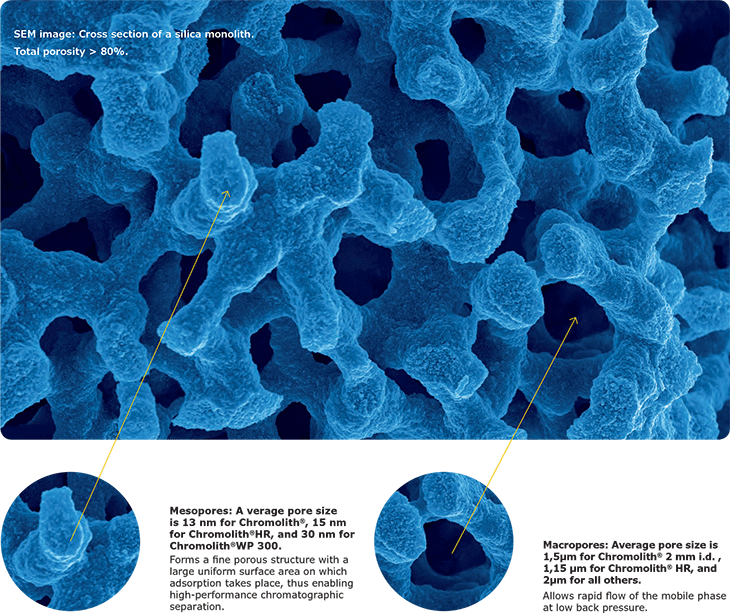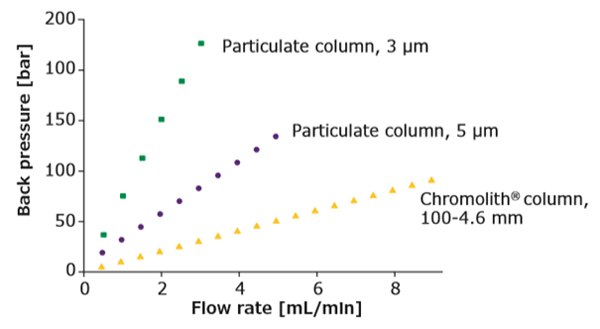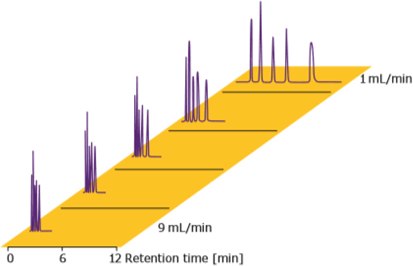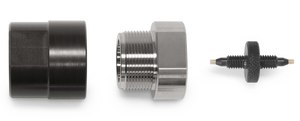Monolithic Silica with Bimodal Pore Structure
Thanks to their patented monolithic silica technology, Chromolith® HPLC columns allow you to race through separations with maximum robustness and selectivity—at minimal back pressure.
- Very high matrix-tolerance and long column life-time
- Enables rapid separations due to very low column back pressure
- High-throughput analysis with excellent separation efficiency and peak capacity
Chromolith® HPLC and UHPLC columns are made from monolithic silica with a bimodal pore structure using sol-gel technology. Mesopores and macropores are formed within the monolithic silica. The column is no longer packed with small particles but consists of a single monolithic piece of high-purity polymeric silica gel.
The mesopores form the fine porous structure within the solid silica in exactly the same way that they do within traditional silica particules. It is the mesopores which provide the high surface area of the silica and on this surface the separation takes place. The separation process itself is virtually the same with both particulate silica columns and with Chromolith® monolithic columns. Therefore, methods can easily be transferred between the two column types. The major difference between particulate and monolithic columns lies in the macropores. The very large 2 µm macropores give the columns very low backpressure and enable very fast analysis. The revolutionary bimodal pore structure of Chromolith® columns provides a unique combination of macropores and mesopores.

Figure 1. Silica monolithic HPLC column for low back pressure separations
Speed-up Separations at low column backpressure
In practice, this means that separations can, for example, be two times faster at half the column backpressure compared to 5 μm columns. The macropores reduce column back pressure and allow the use of faster flow rates, thereby considerably reducing analysis time. The mesopores form a fine porous structure, which creates a very large active surface area for high-efficiency separations. Column re-equilibration between analyses can be performed very quickly at high flow rates.

Figure 2. Column back pressure at different flow rates. Comparison of a Chromolith® Performance column, 100-4.6 mm vs. equivalent classical particulate HPLC columns.
Chromolith® Performance RP-8 endcapped 100-4.6 HPLC column | ||
|---|---|---|
| Column | Chromolith® Performance RP-18 encapped 100-4.6 mm | |
| Mobile phase | Isocratic acetonitrile / 0.1 % trifluoroacetic acid in water, 20/80 (v/v) | |
| Pressure | Total pressure (including HPLC) system at 25 °C | |
| Detection | UV 220 nm | |
| Injection Volume | 5 µL | |
| Sample | Atenolol Pindolol Metoprolol Celiprolol Bisoprolol | 63 µg/mL 29 µg/mL 108 µg/mL 104 µg/mL 208 µg/mL |

Figure 3. Analysis speed
With Chromolith® columns, flow rates can now easily be varied from 1 mL up to 9 mL per minute with the same high-quality resolution. A mixture of five beta-blocker drugs was analyzed to demonstrate the extreme time savings and high separation efficiency made possible with Chromolith® columns. Due to excellent mass transfer properties of the monolithic skeleton, high-speed separation was possible, even at high flow rates. The beta-blockers were well separated with excellent peak symmetry. At 9 mL/min, analysis time was less than 1 minute, and the column back pressure was only 153 bar.
Column Robustness and Matrix-Tolerance
The large macropores also provide a second unique benefit. Whereas particulate columns frequently get blocked or plugged by matrix-rich samples (e.g. food samples or biological samples), Chromolith® monolithic columns are very much more resistant to blockage. The reason is simple – the 2 µm macropore is not easily blocked by matrix material in the sample. This means that the amount of sample preparation required can be reduced, even for complex samples. Filtration through a 0.45 µm luer-tip filter is frequently the only sample preparation required, possibly with a protein precipitation step for biological samples.

Figure 4. Effect on time for HPLC and UHPLC separation of matrix-rich samples when SPE is needed for UHPLC to extend the column lifetime
Column lifetimes are frequently many times longer than for particulate columns for the same analysis. Longer columns can also easily be used since the column backpressures are so low. This is achieved by coupling columns together, which gives very high theoretical plate numbers for separating complex multi-component samples.
Chromolith® Columns for Small Molecule Separations - I | |||||||
|---|---|---|---|---|---|---|---|
| Length (mm) | I.D. (mm) | RP-18e | HR RP-18e | RP-8e | HR RP-8e | Phenyl | |
| Chromolith® HPLC Column [1 unit] | |||||||
| 25 | x | 4.6 | 1.51463.0001 | 1.52020.0001 | 1.52056.0001 | ||
| 25 | x | 3 | 1.52003.0001 | ||||
| 25 | x | 2 | 1.52014.0001 | 1.52320.0001 | |||
| 50 | x | 4.6 | 1.51450.0001 | 1.52021.0001 | 1.52057.0001 | ||
| 50 | x | 3 | 1.52002.0001 | ||||
| 50 | x | 2 | 1.52007.0001 | 1.52321.0001 | |||
| 100 | x | 4.6 | 1.02129.0001 | 1.52022.0001 | 1.51468.0001 | 1.52064.0001 | 1.52058.0001 |
| 100 | x | 3 | 1.52001.0001 | ||||
| 100 | x | 2 | 1.52006.0001 | 1.52322.0001 | |||
| 150 | x | 4.6 | 1.52023.0001 | ||||
| 100 | x | 10 | 1.52016.0001 | ||||
| 100 | x | 25 | 1.25252.0001 | ||||
| Validation Kits [3 Chromolith® HPLC cartidges from 3 different sorbent batches] | |||||||
| 50 | x | 2 | 1.52062.0001 | ||||
| 100 | x | 4.6 | 1.51466.0001 | 1.52019.0001 | |||
| 100 | x | 3 | 1.52063.0001 | ||||
| 100 | x | 10 | 1.52036.0001 | ||||
| Chromolith® Guard cartidges [3 units] | |||||||
| 5 | x | 4.6 | 1.51451.0001 | 1.52025.0001 | 1.52013.0001 | 1.52059.0001 | |
| 10 | x | 4.6 | 1.51452.0001 | ||||
| 5 | x | 3 | 1.52005.0001 | ||||
| 5 | x | 2 | 1.52009.0001 | 1.52325.0001 | |||
| Chromolith® Guard cartidge Set [1 starter kit with holder and 3 guard cartridges] | |||||||
| 5 | x | 2 | 1.52008.0001 | ||||
| 5 | x | 3 | 1.52004.0001 | ||||
Chromolith® columns for small molecule separations - II | ||||||
|---|---|---|---|---|---|---|
| Length (mm) | I.D. (mm) | CN | Diol | NH2 | Si | |
| Chromolith® HPLC Column [1 unit] | ||||||
| 25 | x | 4.6 | 1.52046.0001 | 1.53170.0001 | 1.52026.0001 | |
| 25 | x | 3 | ||||
| 25 | x | 2 | ||||
| 50 | x | 4.6 | 1.52047.0001 | 1.53171.0001 | 1.52027.0001 | |
| 50 | x | 3 | ||||
| 50 | x | 2 | ||||
| 100 | x | 4.6 | 1.52048.0001 | 1.53172.0001 | 1.52028.0001 | 1.51465.0001 |
| 100 | x | 3 | ||||
| 100 | x | 2 | ||||
| 150 | x | 4.6 | ||||
| 100 | x | 10 | 1.52015.0001 | |||
| 100 | x | 25 | 1.25251.0001 | |||
| Validation Kits [3 Chromolith® HPLC cartidges from 3 different sorbent batches] | ||||||
| 50 | x | 2 | ||||
| 100 | x | 4.6 | ||||
| 100 | x | 3 | ||||
| 100 | x | 10 | 1.52035.0001 | |||
| Chromolith® Guard cartidges [3 units] | ||||||
| 5 | x | 4.6 | 1.52050.0001 | 1.53175.0001 | 1.52030.0001 | 1.52011.0001 |
| 10 | x | 4.6 | ||||
| 5 | x | 3 | ||||
| 5 | x | 2 | ||||
| Chromolith® Guard cartidge Set [1 starter kit with holder and 3 guard cartridges] | ||||||
| 5 | x | 2 | ||||
| 5 | x | 3 | ||||
Chromolith® CapRod® Capillary Columns | ||||||
|---|---|---|---|---|---|---|
| Length (mm) | I.D. (mm) | HR RP-18e | RP-18e | RP-8e | ||
| Chromolith®CapRod® HPLC capillary columns [1 unit] | ||||||
| 50 | x | 0.1 | Trap | 1.50426.0001 | ||
| 50 | x | 0.2 | Trap | 1.50409.0001 | ||
| 150 | x | 0.05 | 1.50403.0001 | |||
| 150 | x | 0.1 | 1.50404.0001 | 1.50402.0001 | 1.50400.0001 | |
| 150 | x | 0.2 | 1.50407.0001 | 1.50405.0001 | ||
| 300 | x | 0.1 | 1.50424.0001 | |||
Chromolith® WP 300 for Biomolecule Separation | |||||||
|---|---|---|---|---|---|---|---|
| Length (mm) | I.D. (mm) | RP-18 | RP-8 | RP-4 | Protein A | Epoxy | |
| Chromolith® WP 300 HPLC Column [1 unit] | |||||||
| 25 | x | 4.6 | 1.52258.0001 | 1.52252.0001 | |||
| 25 | x | 2 | 1.52358.0001 | 1.52352.0001 | |||
| 50 | x | 4.6 | 1.52271.0001 | 1.52266.0001 | 1.52261.0001 | 1.52251.0001 | |
| 50 | x | 2 | 1.52371.0001 | 1.52361.0001 | 1.52351.0001 | ||
| 100 | x | 4.6 | 1.52270.0001 | 1.52265.0001 | 1.52260.0001 | 1.52250.0001 | |
| 100 | x | 2 | 1.52370.0001 | 1.52360.0001 | 1.52350.0001 | ||
| Chromolith® Guard cartidges [3 units] | |||||||
| 5 | x | 4.6 | 1.52273.0001 | 1.52268.0001 | 1.52263.0001 | 1.52254.0001 | |
| 5 | x | 2 | 1.52372.0001 | 1.52362.0001 | 1.52353.0001 | ||
| 10 | x | 4.6 | 1.52272.0001 | 1.52267.0001 | 1.52262.0001 | 1.52253.0001 | |
To continue reading please sign in or create an account.
Don't Have An Account?
